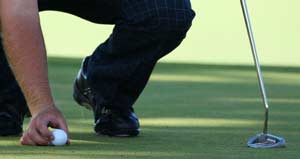The Hacker: With root and branch reform I may finally come out of shade

"I think that I will never see a poem lovely as a tree."
So wrote Joyce Kilmer – a man, as if it matters – in 1913 and I wholeheartedly agree with him, apart from when my ball is stuck behind one.
Furthermore I have to confess that my greatest pleasure on the golf course this year has been hearing the sound of chainsaws, as our groundstaff have set about tree-felling at a rapid rate.
At the last count, they'd cut down 66 and there's more to come, although the fate of a few will depend on the result of a heated debate soon to be held at the club.
But to put Mr Kilmer's rotating remains to rest we are not talking about the sort of trees he loved. We are talking about leylandii, cypress conifers which grow quicker than Jack's beanstalk and are capable of causing controversy wherever they sprout.
There are an estimated 10,000 ongoing disputes between neighbours over the height of these impenetrable green monsters. There's a £1,000 fine for failing to control them.
On a golf course they are an abomination, particularly to hackers like me who have trouble hitting the ball straight. Obviously, if your ball lands among trees there is no one to blame but yourself, but with normal trees the branches start about head height.
With leylandii the branches are at ground level and can measure 10 or 12 feet across. We have thick clusters of them with hardly any gaps. It could take a player of my accuracy weeks to get out.
Worse still, a ball can easily get stuck in its tangled interior. To lose a ball up a tree is not a happy outcome.
What we didn't realise is how many we have. Even with the 66 recently downed we still have almost 700. No wonder I find it so difficult.
We began to plant them after losing many trees to Dutch elm disease. Because they grow so quickly they helped to define holes and act as screens around tees and between fairways.
But now they dominate the place and when the renowned course architect Donald Steel was asked recently to give the course the once over he recommended that the club "should face up to a drastic culling" of the leylandii.
Being dense and low-slung, he said, they are bad golfing trees in the playing sense. "The punishment for missing the fairways must fit the crime and leylandii can punish wayward shots too severely," was his ruling.
So the cull is taking place. There are some the better players want kept and the not so good players want removed and we are to have a general meeting to argue about it.
Making the course a little easier coupled with a slight improvement in the two games I've been able to play, gives me every hope that this is the year of my breaking through the 100 barrier.
It would certainly help if I could stop my head shooting up as I make contact with the ball. I intend to keep repeating to myself a story sent to me by a reader in Donegal.
A hacker playing at a posh course is given the services of a caddy. After playing atrociously for 17 holes he gazes at a lake adjoining the 18th tee and says: "The best thing I can do is drown myself."
"I doubt if you could, sir," said the caddy. "You wouldn't be able to keep your head down long enough."
Tip of the week
No 38: perfect posture
Posture is often overlooked when setting up to the ball, but is as important as the other set-up factors. Posture will help determine your distance from the ball and weight distribution during the swing. It will determine the plane of your swing as your spine angle changes depending on club selection.
Firstly, stand upright with your feet shoulder width apart and your club held parallel to the ground, out in front of you with the butt pointing towards your belt buckle. Now tip forwards from the hips, allowing your knees to straighten and your bottom to sit behind your heels. Try to keep your chin up and back straight as you bend, until the club reaches the ground. Flex your knees to allow the weight to return to the balls of your feet.
At address remember to have your weight even between your left and right foot for all iron shots and favouring your right foot for woods. Now you're ready to swing...
Simon Iliffe, Head Pro, Purley Downs GC, Surrey
Subscribe to Independent Premium to bookmark this article
Want to bookmark your favourite articles and stories to read or reference later? Start your Independent Premium subscription today.

Join our commenting forum
Join thought-provoking conversations, follow other Independent readers and see their replies